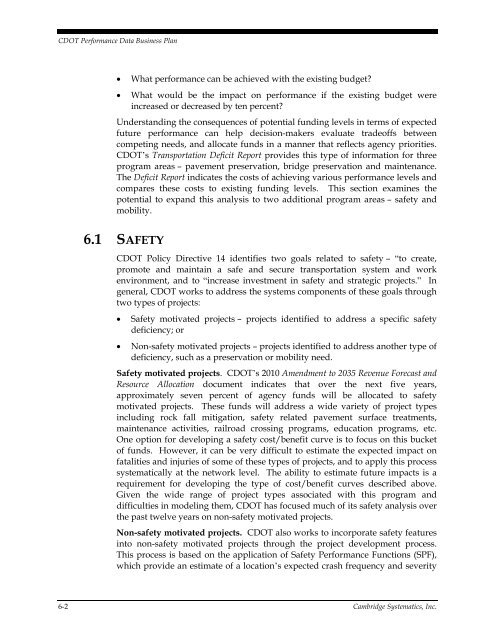CDOT Performance Data Business Plan - Cambridge Systematics
CDOT Performance Data Business Plan - Cambridge Systematics
CDOT Performance Data Business Plan - Cambridge Systematics
Create successful ePaper yourself
Turn your PDF publications into a flip-book with our unique Google optimized e-Paper software.
<strong>CDOT</strong> <strong>Performance</strong> <strong>Data</strong> <strong>Business</strong> <strong>Plan</strong><br />
<br />
<br />
What performance can be achieved with the existing budget?<br />
What would be the impact on performance if the existing budget were<br />
increased or decreased by ten percent?<br />
Understanding the consequences of potential funding levels in terms of expected<br />
future performance can help decision-makers evaluate tradeoffs between<br />
competing needs, and allocate funds in a manner that reflects agency priorities.<br />
<strong>CDOT</strong>’s Transportation Deficit Report provides this type of information for three<br />
program areas – pavement preservation, bridge preservation and maintenance.<br />
The Deficit Report indicates the costs of achieving various performance levels and<br />
compares these costs to existing funding levels. This section examines the<br />
potential to expand this analysis to two additional program areas – safety and<br />
mobility.<br />
6.1 SAFETY<br />
<strong>CDOT</strong> Policy Directive 14 identifies two goals related to safety – “to create,<br />
promote and maintain a safe and secure transportation system and work<br />
environment, and to “increase investment in safety and strategic projects.” In<br />
general, <strong>CDOT</strong> works to address the systems components of these goals through<br />
two types of projects:<br />
<br />
<br />
Safety motivated projects – projects identified to address a specific safety<br />
deficiency; or<br />
Non-safety motivated projects – projects identified to address another type of<br />
deficiency, such as a preservation or mobility need.<br />
Safety motivated projects. <strong>CDOT</strong>’s 2010 Amendment to 2035 Revenue Forecast and<br />
Resource Allocation document indicates that over the next five years,<br />
approximately seven percent of agency funds will be allocated to safety<br />
motivated projects. These funds will address a wide variety of project types<br />
including rock fall mitigation, safety related pavement surface treatments,<br />
maintenance activities, railroad crossing programs, education programs, etc.<br />
One option for developing a safety cost/benefit curve is to focus on this bucket<br />
of funds. However, it can be very difficult to estimate the expected impact on<br />
fatalities and injuries of some of these types of projects, and to apply this process<br />
systematically at the network level. The ability to estimate future impacts is a<br />
requirement for developing the type of cost/benefit curves described above.<br />
Given the wide range of project types associated with this program and<br />
difficulties in modeling them, <strong>CDOT</strong> has focused much of its safety analysis over<br />
the past twelve years on non-safety motivated projects.<br />
Non-safety motivated projects. <strong>CDOT</strong> also works to incorporate safety features<br />
into non-safety motivated projects through the project development process.<br />
This process is based on the application of Safety <strong>Performance</strong> Functions (SPF),<br />
which provide an estimate of a location’s expected crash frequency and severity<br />
6-2 <strong>Cambridge</strong> <strong>Systematics</strong>, Inc.

















